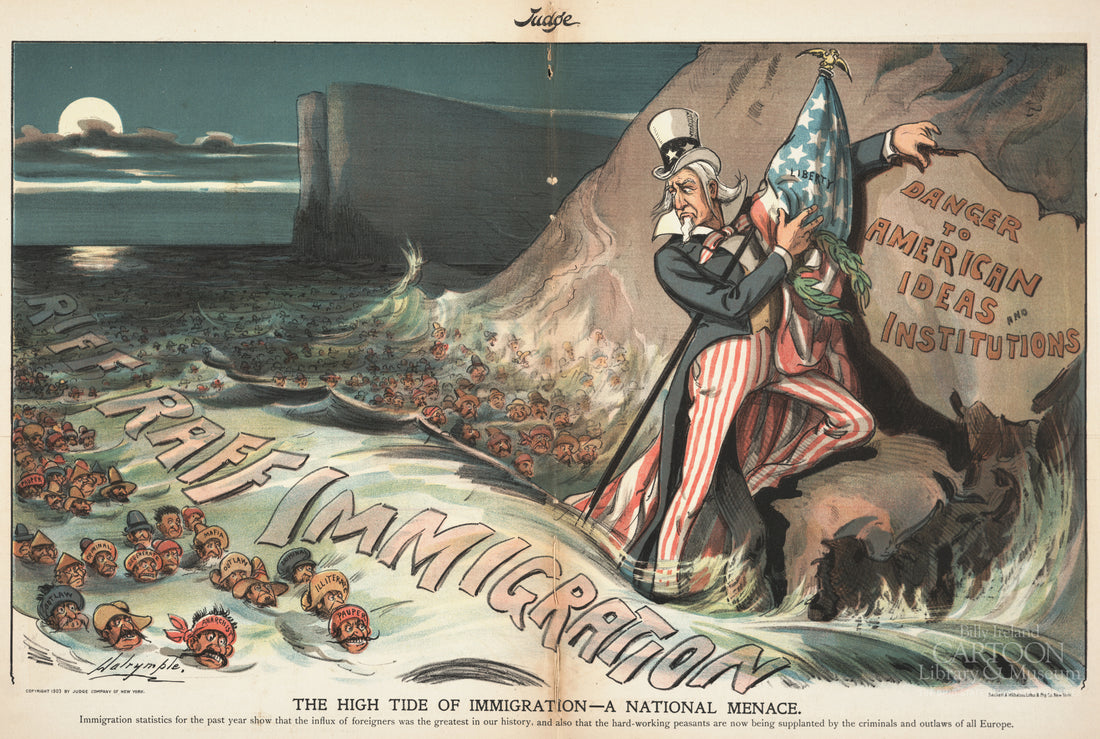Tom Buchanan: Racist Bigot
After the Nick Carraway sits down for dinner on the Buchanans’ house, Tom Buchanan announces that he has been reading a book called “‘The Rise of the Colored Empires’ by this man Goddard” (12). Anyone reading The Great Gatsby in the 1920s would have recognized the book that Tom is reading as a thinly veiled reference to an actual book: Lothrop Stoddard’s The Rising Tide of Color: The Threat Against White World-Supremacy (1920).
Lothrop Stoddard’s The Rising Tide of Color was one of several books that incited a wave of racism and xenophobia that swept through the United States in the 1920s. Widespread anti-immigrant sentiment led to the passage of the Immigration Act of 1924, which restricted immigration from African countries and banned all immigration from Asian countries. What does Tom’s fondness for this book reveal about his personality? Why might Tom feel threatened by the alleged “rise” of the “colored empires” (12)?
While Tom Buchanan enjoyed a certain social prestige as a football star at Yale University, the narrator recognizes that Tom peaked in college and has been struggling ever since to regain the same feeling of unshakeable dominance. In an effort to recover a sense of superiority that he enjoyed in college, Tom now resorts to belittling and condescending to other people. He is described as having “arrogant eyes” which make it seem as if he’s always “leaning aggressively forward” and thereby looking down upon others; and he is described as speaking to others with a tone of “paternal contempt” (7).
What’s even more disturbing is that Tom’s desire to recover a sense of his own superiority has driven him to embrace the pseudo-scientific theory of white supremacy put forth in Goddard’s The Rise of the Colored Empires. Tom exposes himself as a racist bigot when he regurgitates the specious argument of Goddard’s book: “The idea is if we don’t look out the white race will be — will be utterly submerged. […] It’s up to us, who are the dominant race, to watch out or these other races will have control of things” (13). Thus, from the very first chapter of Fitzgerald’s novel, it should be clear that Tom Buchanan embodies a dangerous combination of racial privilege, gender privilege, and class privilege — topped off by an enormous physical stature that renders him violent and volatile.…
Tom Buchanan may get characterized as having a “cruel” body because he embodies the forces that entrench or sediment social hierarchies. Literary scholar Brian Way points out that Tom’s propensity to commit violence is only thinly veiled by his fashionable clothes and composed demeanor: “His brutality is constantly breaking through the veneer of his surface gentility, just as the movements of his ‘cruel body’ show under the ‘effeminate swank’ of his riding clothes.” In an insightful analysis, Brian Way elaborates, “Tom’s style of physical dominance, his capacity for exerting leverage, are not expressions merely of his individual strength but of the power of a class. Fitzgerald does not make the mistake of imagining that because the rich are corrupt, they must necessarily be weak. […] Tom Buchanan is a far truer representative: he draws on the sense of self-assurance his money and position give him as directly as he draws upon his bank account.” (Brian Way, “The Great Gatsby.” F. Scott Fitzgerald’s The Great Gatsby. Ed. Harold Bloom. New York: Chelsea House, 1986. 44.)
But how does Daisy Buchanan respond when Tom announces that he’s been reading Goddard’s The Rise of the Colored Empires? How does Daisy respond when Tom expresses his concern that the “rise” of the “colored empires” is going to leave white people “utterly submerged” (13)? Does Daisy share her husband’s racist and xenophobic worldview?...
Daisy Buchanan: Complicit in Tom’s Racism?
When Tom announces that he has been reading Goddard’s The Rise of the Colored Empires, Daisy responds with an ironic comment which pokes fun at the fact that, until now, Tom has never seemed all that interested in reading: “Tom’s getting very profound. […] He reads deep books with long words in them” (13; emphasis mine). Tellingly, Tom interrupts his wife in order to proceed with his racist and xenophobic rant, asserting, “It’s up to us, who are the dominant race, to watch out or these other races will have control of things” (13).
Upon hearing Tom assert that they’re members of the “dominant race,” Daisy makes a second ironic comment which pokes fun at Tom’s racial paranoia and reactionary brutality: “‘We’ve got to beat them down,’ whispered Daisy, winking ferociously toward the fervent sun” (13; emphasis mine). By describing Daisy as “winking ferociously” as she speaks, the author makes it unequivocally clear that Daisy is speaking ironically and that she is attempting to distance herself from her husband’s racist and xenophobic worldview.
Because I’ve been surprised to find that some students, when reading this chapter for homework, don’t catch the irony in Daisy’s response, I usually read her response aloud in class, adding emphasis to the words and phrases that Daisy uses to signal that she’s being ironic: “very profound,” “deep books,” “long words,” “got to beat them down.” Then I explain that people use verbal irony when they want listeners to understand that while they may be saying one thing, they actually mean the opposite. (A classic example of verbal irony can be found when there’s a storm raging outside and someone remarks, “Nice weather we’re having!”). Finally, I ask students whether they think Daisy is being sincere or ironic when she asserts, “We’ve got to beat them down.”
Verbal irony is often used either to bring levity to a situation or to poke fun at another person; and Daisy is clearly doing both of these things when she pretends to endorse Tom’s racist statements — statements which she clearly finds despicable and embarrassing.
For his part, Fitzgerald might be said to use this scene to critique the pseudo-scientific discourse on race that was being popularized in the 1920s. For Tom’s statements illuminate how this discourse could incite racial paranoia and social panic in white Americans. When Nick admits that the rapid banter between Daisy and Jordan makes him feel “uncivilized,” Tom takes up Nick’s remark in an “unexpected way” by “violently” asserting, “Civilization’s going to pieces” (12). Tom proceeds to equate “civilization” with the “white race,” exclaiming that white people have “produced all the things that go to make civilization — oh, science and art, and all that” (13).
Not only is Tom’s assertion about “civilization” historically incorrect, but the manner in which Tom awkwardly invokes “science and art, and all that” reflects that he has very little interest in the arts and sciences per se, but is merely invoking them to support his specious theory of white supremacy.
Even more troubling is Tom’s assertion that the “colored empires” threaten to leave white people “utterly submerged.” This assertion frames people of color as a tidal wave — or an undifferentiated mass — which threatens to overwhelm Western civilization. The very title of Lothrop Stoddard’s The Rising Tide of Color invokes this same racist metaphor comparing people of color to a homogeneous and threatening tidal wave. By helping students to analyze and critique the racist assumptions which underlie such metaphors, teachers can help to prevent their spread in the future!
Teach It Today...
If you’re a teacher who’d like to explore how Fitzgerald uses The Great Gatsby to critique the prejudices and inequalities related to race, class, and gender, you’ll definitely want to check out this Complete Teaching Unit on The Great Gatsby. The 200-page resource packet includes discussion questions, vocabulary lists, reading quizzes, and writing tasks for every chapter of The Great Gatsby. It also features special-topics worksheets on the novel’s symbolic settings, literary devices, color symbolism, socioeconomic hierarchies, and much more!
Save yourself hundreds of hours of prep time while motivating your students to be highly engaged. Check out this Complete Teaching Unit on The Great Gatsby!
Image Credit: Louis Dalrymple, "The High Tide of Immigration — A National Menace," Judge Magazine (August 22 1903). Courtesy of the Billy Ireland Cartoon Library & Museum.

